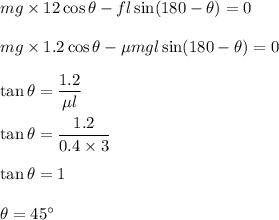
Physics, 15.04.2020 17:27 MichaelG07
A 75.0 kg ladder that is 3.00 m in length is placed against a wall at an angle theta. The center of gravity of the ladder is at a point 1.2 m from the base of the ladder. The coefficient of static friction at the base of the ladder is 0.400. There is no friction between the wall and the ladder. What is the minimum angle the ladder makes with the horizontal for the ladder not to slip and fall

Answers: 3


Other questions on the subject: Physics



Physics, 22.06.2019 01:40, sasalinas2001
In all trials, the magnitude of the final velocity for g1 + g2 was less than the magnitude of any initial velocity. as mass increased, what happened to the velocity? the velocity decreased. the velocity increased. the velocity of g1 + g2 could not be measured. the velocity was not affected by the mass increase.
Answers: 1

Physics, 22.06.2019 13:40, andrespiperderc
Use the profile illustrated for problem (1). assume that the layer of silty sand fill (sm) is placed over the entire site. estimate the thickness of the fill (h - in feet) that will cause the effective vertical stress at the center of the clay layer to increase by 517.5 pounds per square foot.
Answers: 1
You know the right answer?
A 75.0 kg ladder that is 3.00 m in length is placed against a wall at an angle theta. The center of...
Questions in other subjects:



Computers and Technology, 11.02.2021 20:40

English, 11.02.2021 20:40

Arts, 11.02.2021 20:40


Mathematics, 11.02.2021 20:40



Mathematics, 11.02.2021 20:40





